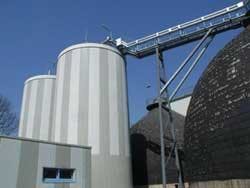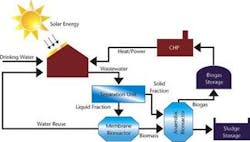Decentralised infrastructure saves system costs, produces biogas energy
By Stefan Holler
Currently, the management of sustainable infrastructure is one of the most pressing global issues as urban centres continue to expand. Ensuring basic human services, such as water supply and wastewater treatment, is one of many challenges faced by researchers and managers in the 21st century.
Sanitary reforms of the 19th and 20th century resulted in centralised infrastructure within industrialised countries that cannot be replicated in developing and emerging countries. Industrialised countries invested vast amounts of financial resources in centralised water and wastewater infrastructure over an extremely long period of time, making it macro-economically possible. However, economic alternatives are needed in fast-developing countries where no or only rudimentary pre-investment has taken place. In addition, technical alternatives are clearly in demand because drinking water quality is poor in many countries.
Conventional centralised infrastructure for water supply and wastewater treatment does not follow the demands of sustainable sanitation because it depends on an extended pipeline system. Conventional systems require high investment costs. Large networks incur high operation and maintenance expenses. In addition, high water losses can occur in large systems for water distribution and sewage collection, respectively. Consequently, an alternative approach towards a sustainable sanitation should combine the demands of a reliable technology as well as economic feasibility. This can be achieved by decentralisation.
From an economic point of view, the most important advantage of decentralisation is reduced investment costs for the network. If wastewater treatment facilities are located close to the source of wastewater, such as in housing areas, the construction of an extended sewerage system is no longer necessary. Instead, treated water can be reused for domestic applications or for irrigation.
Regarding conventional wastewater systems, large pipelines are considered necessary because they also transport stormwater drainage; however innovative decentralised drainage technologies for stormwater treatment already exist. In addition, stormwater is often high quality and can replenish valuable water resources and reduce the demand for drinking water. Consequently, water distribution pipelines could be reduced in dimension, which reduces construction costs. Furthermore, operation and maintenance costs of the distribution network would decrease along with the amount of unaccounted-for-water.
A decentralised water infrastructure could also increase the demand for small and efficient water treatment units. This would lead to the development of a new sector of high-tech products manufactured in mass production, which would eventually decrease prices for decentralised technology.
Given the growing problem of water shortages in many global regions, the more efficient use and reuse of water in alternative decentralised systems would greatly benefit water-scarce areas. The potential of alternative wastewater treatment technology is enormous. Human waste streams can be reused, advanced technology can improve the quality of effluent water, and biogas can be generated from wastewater.
Generally, it is accepted that the introduction of a new technology can only be accomplished successfully if users and operating personnel receive intensive teaching and training. Alternative water systems have the advantage that they can be designed in such a way that flexible and easy adaptation towards local needs is possible. This advantage simplifies the general approval process.
An innovative decentralized infrastructure system could eliminate the need to expand sewerage systems; thereby reduce necessary investment capital costs in addition to operation and maintenance costs of the expanded pipeline system. The core of this type of system is an advanced wastewater treatment process that achieves two goals — purifies water to allow its reuse and creates energy from organic material in the wastewater stream.
Adopting this system requires a change in how we view wastewater treatment. The main task of wastewater treatment is no longer only disposal; the process should be used to recover energy and usable water from human waste streams.
The system could treat municipal wastewater in regions without an infrastructure for water and energy supply. Especially, it shows its advantages at local sites without existing wastewater treatment facilities or in regions with a permanent shortage of drinking water.
Energy recovery takes place by converting organic material from waste and wastewater streams into biogas and then using biogas as an energy source. Innovative membrane technology can be used in wastewater treatment to reclaim water from wastewater. This results in three core achievements:
• First, the environmental pollution by wastewater and waste deposition can be reduced;
• Second, the energy supply by fossil resources can be replaced; and
• Third, purified wastewater can be reused for irrigation and domestic use.
Separating all solid material from the wastewater stream can produce the maximum yield of biogas. This first step takes place in the separation unit from which the solid fraction of the wastewater is transferred directly to an anaerobic bioreactor. The resulting wastewater stream is further treated in a membrane bioreactor (MBR), where organic substances are converted into biomass and carbon dioxide through a microbiological process. Different types of MBRs are available and all employ advanced membrane technology to separate biomass from treated water.
The effluent can be reused for various needs, such as irrigation and toilet flushing. Disinfection must be integrated depending on local requirements and the purposes of water reuse. The biomass from the MBR is transferred to the anaerobic bioreactor, where biogas is produced. The biogas is collected in a storage tank and can then be converted into energy in a combined heat and power unit (CHP).
Table 1 shows the energy potential of the described process for two scenarios. In the first scenario, the wastewater stream contains only wastewater from toilet, washing and cleaning. In the second scenario, biowaste from kitchen residues is added to the solid fraction, which is fed into the anaerobic bioreactor. A significant increase of biogas production can be achieved through this co-fermentation of organic waste. The energy content of the wastewater load (scenario 1) reached up to 100 kWh per person in one year; however the amount of usable energy increased to 250 kWh per person in one year when biomass and biowaste were co-fermented.
Energy produced from the CHP often does not meet local energy demands, so an additional energy source is necessary. This supplemental energy can be produced from regenerative sources, for example, solar energy, wind power or fuel cells, to become completely independent from centralised power supply.
Summary
Decentralised infrastructure systems offer great potential to reduce the necessary capital investment and operational and maintenance costs for water and sewerage networks. Consequently, this alternative approach to integrated water management offers a promising alternative to conventional centralised systems, not only to municipalities but also to private water and energy utilities.
Decentralised infrastructure meets the criteria of sustainability and follows the multi-utility concept because it allows for a combination of different technologies. In addition, this approach enables planners to remain flexible and adapt innovations to work more efficiently with local requirements. Highly qualified personnel are absolutely required to operate the highly technological and sensitive biological processes, but decentralised systems are technologically feasible and affordable. This system, therefore, offers a sustainable, economical solution to the widespread lack of water and wastewater infrastructure in many countries, especially developing and emerging countries that are faced with increasing demands for water supply.
Author's noteDr. Stefan Holler wrote his doctoral thesis on the topic of municipal wastewater treatment in a membrane bioreactor, while working at the Fraunhofer Institute for Interfacial Engineering and Biotechnology in Germany. He is now a project manager at the MVV Energie AG and can be contacted at Email: [email protected].



